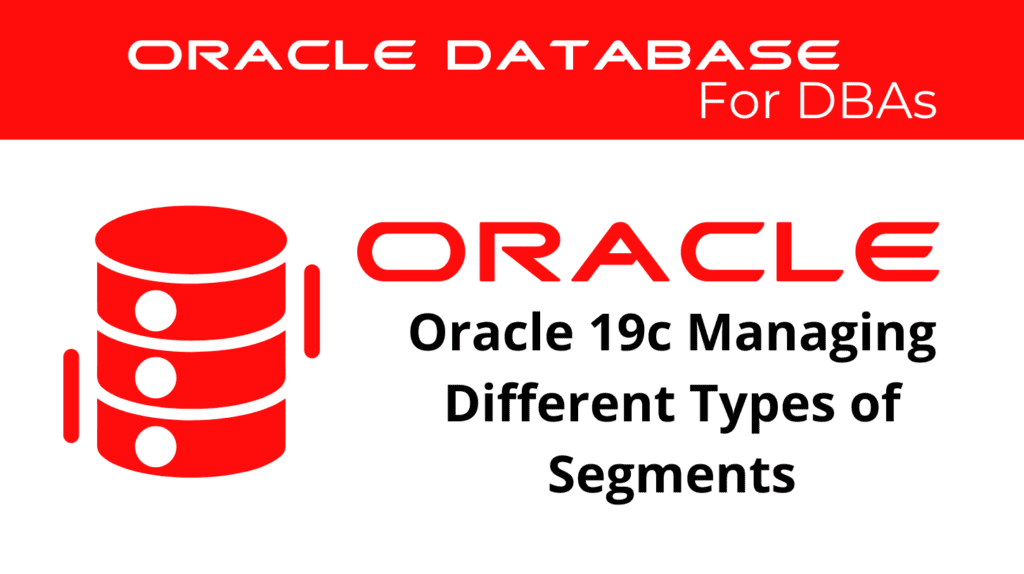
Managing Segments in Oracle 19c is crucial for database administrators to ensure optimal performance and efficient storage use. In this tutorial, we will explore various aspects of Managing Segments, focusing on different Segment Types and their management. Understanding how to effectively manage these segments is essential for maintaining a well-organized and high-performing database system. We will delve into the types of segments available, how to create and alter them, and the best practices for monitoring and optimizing these segments in Oracle 19c.
Understanding Segment Types
In Oracle 19c, segments are the physical storage structures that store data. Different Segment Types serve various purposes, and understanding these types is vital for effective Segment Management. The primary Segment Types include tables, indexes, partitions, and LOB segments.
Tables: Tables are the basic storage structures in Oracle databases. They store rows of data and are the most common Segment Type. Managing tables involves tasks such as creating, altering, and dropping tables, as well as optimizing their storage.
-- Example of creating a table
CREATE TABLE employees (
employee_id NUMBER PRIMARY KEY,
first_name VARCHAR2(50),
last_name VARCHAR2(50),
email VARCHAR2(100),
hire_date DATE
);
Indexes: Indexes are used to speed up data retrieval. They are another essential Segment Type. Effective management of indexes includes creating appropriate indexes for queries, rebuilding fragmented indexes, and monitoring index usage to ensure optimal performance.
-- Example of creating an index
CREATE INDEX idx_employees_last_name ON employees (last_name);
Partitions: Partitioning is a method to divide and Managing Segments for large tables or indexes into smaller, more manageable pieces. Each piece, or partition, can be managed separately. This Segment Type is crucial for handling large datasets and improving query performance.
-- Example of creating a partitioned table
CREATE TABLE sales (
sale_id NUMBER,
sale_date DATE,
amount NUMBER
)
PARTITION BY RANGE (sale_date) (
PARTITION p1 VALUES LESS THAN (TO_DATE('2022-01-01', 'YYYY-MM-DD')),
PARTITION p2 VALUES LESS THAN (TO_DATE('2023-01-01', 'YYYY-MM-DD'))
);
LOB Segments: Large Object (LOB) segments store large data such as text, images, or videos. Managing LOB segments involves tasks such as optimizing storage and ensuring efficient access to the large objects.
-- Example of creating a table with LOB segment
CREATE TABLE documents (
doc_id NUMBER PRIMARY KEY,
doc_name VARCHAR2(100),
doc_content CLOB
);
Creating and Altering Segments
Creating segments is the first step in Managing Segments. Using the appropriate SQL commands, we can create tables, indexes, partitions, and LOB segments. For example, the CREATE TABLE statement is used to create a table segment, while CREATE INDEX is used for index segments.
-- Example of altering a table to add a new column
ALTER TABLE employees ADD (phone_number VARCHAR2(20));
Altering segments involves modifying their structure or properties. This can be done using commands such as ALTER TABLE or ALTER INDEX. Altering segments might include tasks like adding or dropping columns, changing storage parameters, or partitioning a table.
-- Example of altering an index
ALTER INDEX idx_employees_last_name REBUILD;
📢 You might also like: Oracle 19c Using Table and Row Compression (Category: Oracle Database Admin)
Monitoring and Optimizing Segments
Effective Segment Management involves continuous monitoring and optimization. Oracle 19c provides various tools and views, such as DBA_SEGMENTS and DBA_FREE_SPACE, to monitor the usage and free space of segments.
To optimize segments, administrators can use techniques like rebuilding indexes to eliminate fragmentation, coalescing free space, and compressing tables. These optimizations help in maintaining efficient storage and improving performance.
-- Example of checking segment space usage
SELECT segment_name, bytes FROM dba_segments WHERE segment_type = 'TABLE';
Managing Segments – Handling Segment Fragmentation
Fragmentation occurs when segments have free space scattered throughout, leading to inefficient storage and performance degradation. Managing Segments involves regular checks for fragmentation and taking appropriate actions, such as rebuilding indexes or reorganizing tables.
-- Example of coalescing free space
ALTER TABLE employees COALESCE;
Managing LOB Segments
LOB segments require special attention due to their size and nature. Managing LOB segments includes tasks like setting appropriate storage parameters, enabling SecureFiles for better performance, and regularly monitoring the growth of LOB segments.
-- Example of enabling SecureFiles for a LOB segment
ALTER TABLE documents MODIFY LOB (doc_content) (STORE AS SECUREFILE);
Conclusion
In conclusion, Managing Segments in Oracle 19c is a vital aspect of database administration that ensures optimal performance and efficient storage use. By understanding the different Segment Types and employing effective Segment Management techniques, database administrators can maintain a well-organized and high-performing database system. Regular monitoring, optimizing, and handling fragmentation are key practices in Segment Management. Implementing these practices will lead to better performance, efficient storage, and overall improved database management in Oracle 19c.
See more on Oracle’s website!
Be Oracle Database Certified Professional, this world is full of opportunities for qualified DBAs!





